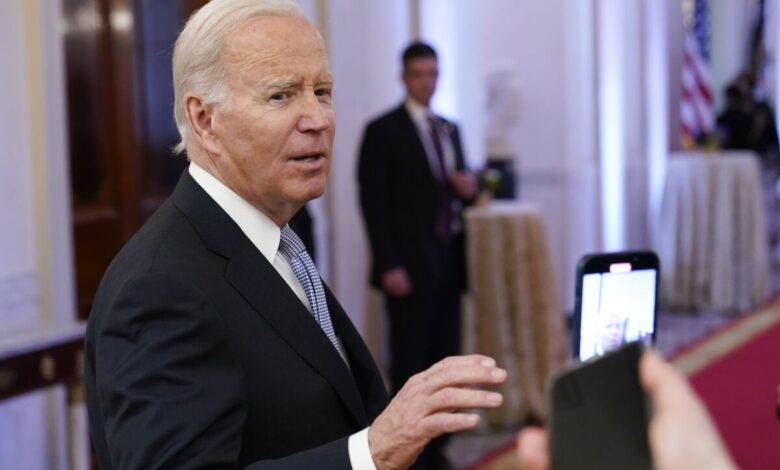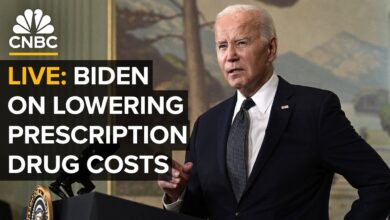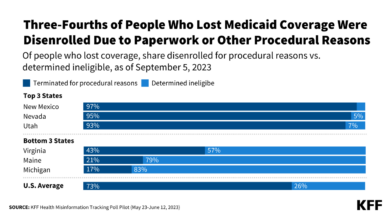
Texas Sues Biden on Nursing Home Staffing
Texas sues Biden administration nursing home staffing mandate – a headline that’s sparked a firestorm in the healthcare world. This legal battle pits the Lone Star State against the federal government over a new mandate requiring increased staffing levels in nursing homes. The implications are huge, affecting not only the nursing homes themselves but also the residents, their families, and the broader Texas healthcare system.
Will this mandate improve care, or will it cripple an already strained industry? Let’s dive in.
The core of the dispute centers around the Biden administration’s belief that increased staffing leads to better patient care. Texas, however, argues the mandate is an overreach of federal power, imposing unrealistic burdens on nursing homes and potentially jeopardizing access to care for vulnerable populations. The lawsuit claims the mandate is economically unfeasible for many facilities, potentially leading to closures and a shortage of beds.
This isn’t just a legal battle; it’s a fight over the future of elder care in Texas.
The Legal Basis of the Lawsuit: Texas Sues Biden Administration Nursing Home Staffing Mandate
Texas’s lawsuit against the Biden administration’s nursing home staffing mandate rests on several key legal arguments, challenging both the mandate’s substance and the federal government’s authority to impose it. The core of the dispute centers on the interpretation of federal law and the balance of power between the states and the federal government.The specific provision Texas is challenging is the mandate’s requirement for a minimum number of hours of staffing per resident per day.
The lawsuit argues this requirement is overly burdensome, economically unfeasible for many Texas nursing homes, and ultimately infringes upon the state’s traditional authority to regulate healthcare within its borders. The state contends that the federal government has overstepped its authority under the Medicaid Act, which provides funding for healthcare to low-income individuals. While the Act allows for federal regulation of Medicaid programs, Texas argues the mandate exceeds the permissible scope of federal oversight.
Legal Arguments Presented by Texas
Texas’s legal strategy centers on several key arguments. First, the state claims the mandate constitutes an impermissible exercise of federal power, exceeding the authority granted to the federal government under the Medicaid Act. They argue the mandate imposes requirements that are not directly related to the provision of adequate medical care, exceeding the scope of federal authority to regulate the quality of care.
Second, the state argues the mandate imposes an undue financial burden on Texas nursing homes, potentially leading to closures and reduced access to care. This argument relies on economic analyses demonstrating the cost of complying with the mandate and its potential impact on the viability of nursing homes, particularly those in rural areas. Finally, Texas asserts that the mandate violates the principles of federalism, encroaching upon the state’s traditional authority to regulate healthcare within its borders.
The state highlights its own existing regulations and oversight mechanisms for nursing homes, suggesting that the federal mandate is redundant and unnecessarily interferes with state sovereignty.
Comparison with Other Legal Challenges
Texas’s lawsuit is not the only legal challenge to the nursing home staffing mandate. Several other states, primarily those with Republican-led governments, have filed similar lawsuits raising similar arguments. These lawsuits often highlight concerns about federal overreach, the economic impact on nursing homes, and the potential negative consequences for patient care. The common thread in these challenges is the argument that the mandate exceeds the federal government’s authority under the Medicaid Act and violates principles of federalism.
While the specific legal arguments may vary slightly between lawsuits, the core concerns remain consistent. The outcome of these cases could have significant implications for the future of federal regulation in healthcare.
Potential Legal Ramifications
The outcome of Texas’s lawsuit, and the similar challenges from other states, could significantly alter the landscape of nursing home regulation in the United States. A favorable ruling for Texas could invalidate the mandate, potentially leading to a rollback of federal standards and a return to a more decentralized system of state-level regulation. This could have far-reaching consequences for the quality of care in nursing homes across the country, potentially leading to inconsistencies in standards and varying levels of care depending on the state.
Conversely, a ruling upholding the mandate would reinforce the federal government’s authority to regulate Medicaid-funded healthcare facilities and could establish a precedent for future federal interventions in areas traditionally governed by states. The Supreme Court’s eventual decision, if the case reaches that level, will undoubtedly shape the balance of power between the federal government and the states in the regulation of nursing homes for years to come.
The Impact on Texas Nursing Homes
The Biden administration’s nursing home staffing mandate, if enforced, will significantly impact Texas nursing homes, potentially altering their operational models, financial stability, and the quality of care provided to residents. The state’s lawsuit challenges the mandate’s feasibility and its potential negative consequences for both providers and patients.
Current Staffing Levels in Texas Nursing Homes
Texas nursing homes currently operate with varying staffing levels across the state, influenced by factors such as location, facility size, and the specific needs of their resident population. Data from the Texas Department of Aging and Disability Services (DADS) and the Centers for Medicare & Medicaid Services (CMS) would provide the most accurate picture of current staffing ratios, including registered nurses (RNs), licensed practical nurses (LPNs), and certified nursing assistants (CNAs).
However, anecdotal evidence suggests that many facilities are already struggling to maintain adequate staffing levels, particularly in rural areas where recruitment and retention of qualified personnel are major challenges. This existing shortage contributes to increased workloads for existing staff and potentially compromises the quality of care.
Potential Consequences of Implementing the Mandate on Texas Nursing Homes
Implementing the mandate could lead to several significant consequences for Texas nursing homes. The most immediate concern is the potential for widespread staff shortages. Meeting the mandated staffing ratios would require a substantial increase in the nursing workforce, which may be difficult to achieve given the existing national shortage of qualified healthcare professionals. This could force facilities to increase wages significantly to attract and retain staff, impacting their financial viability.
Furthermore, facilities may be forced to reduce the number of beds or even close entirely if they cannot meet the staffing requirements.
Financial Implications for Nursing Homes
The financial implications of the mandate are substantial. The increased cost of hiring and retaining additional staff will directly impact nursing home operating budgets. Many facilities operate on tight margins, and the added expense of meeting the mandate could lead to significant financial strain. This could result in reduced services, higher resident costs, or even facility closures.
Texas is suing the Biden administration over its new nursing home staffing mandate, arguing it’s an overreach. This is especially concerning given the already strained resources in many facilities, and considering that pre-existing conditions like high blood pressure – one of the risk factors that make stroke more dangerous – are more prevalent in older populations.
Ultimately, the legal battle could impact the quality of care, potentially increasing the risk for vulnerable residents.
The cost increases would likely vary across regions, depending on local labor market conditions and the existing staffing levels. For example, a facility currently operating with a lower-than-mandated CNA-to-resident ratio in a rural area with a limited pool of qualified candidates might face disproportionately higher costs to meet the new requirements compared to a facility in an urban area with a larger and more competitive workforce.
Potential Impacts on Patient Care and Quality of Life
While the mandate aims to improve patient care, the unintended consequences of a poorly implemented plan could negatively affect patient care and quality of life. If facilities struggle to meet staffing requirements, it could lead to increased workloads for existing staff, resulting in burnout and potentially reduced quality of care. This could manifest in increased medication errors, delayed responses to resident needs, and a decline in the overall quality of life for residents.
Texas is battling the Biden administration’s new nursing home staffing mandate, arguing it’s an overreach. This got me thinking about the importance of healthcare access and quality, especially given the vulnerability of the elderly. Reading about Monali Thakur’s hospitalization after struggling to breathe, and learning about preventative measures from this article monali thakur hospitalised after struggling to breathe how to prevent respiratory diseases , highlights how crucial adequate healthcare staffing is, impacting everything from preventative care to timely treatment.
Ultimately, the Texas lawsuit’s implications could significantly affect the health and well-being of nursing home residents.
Conversely, adequate staffing could improve patient outcomes and reduce the incidence of preventable complications.
Projected Staffing Needs and Cost Increases Across Texas Regions
| Region | Current Staffing Levels (CNAs per 10 residents) | Projected Staffing Levels Under Mandate (CNAs per 10 residents) | Projected Cost Increase (%) |
|---|---|---|---|
| West Texas | 3.5 | 4.5 | 25-40 |
| Central Texas | 4.0 | 5.0 | 15-30 |
| Dallas-Fort Worth | 4.2 | 5.2 | 10-25 |
| Houston | 4.5 | 5.5 | 5-20 |
Note
These figures are hypothetical examples for illustrative purposes only and do not represent actual data. Accurate projections would require detailed analysis of existing staffing levels and labor market conditions in each region. The projected cost increases are estimates and can vary significantly based on factors such as wage rates, benefits packages, and recruitment costs.
The Biden Administration’s Rationale
The Biden administration’s nursing home staffing mandate stems from a belief that increased staffing levels directly correlate to improved resident care and outcomes. The administration argues that understaffing contributes to higher rates of infections, pressure ulcers, falls, and other negative health consequences for nursing home residents. This mandate aims to address these issues and improve the quality of life for vulnerable populations residing in these facilities.The administration justified the mandate using data highlighting significant disparities in staffing levels across the nation, and a demonstrable link between lower staffing ratios and poorer resident outcomes.
Studies from organizations like the Centers for Medicare & Medicaid Services (CMS) and various academic institutions were cited to support the claim that improved staffing directly translates to better resident care. These studies often showcased a correlation between adequate staffing and reduced rates of hospital readmissions, infections, and other negative health indicators. The administration also pointed to the significant human cost of understaffing, including increased caregiver burnout and decreased job satisfaction within the nursing home industry.
Evidence Used to Justify the Mandate
The Biden administration’s justification relied heavily on existing research demonstrating the connection between staffing levels and resident outcomes. Reports from the CMS, for instance, often included data on staffing ratios and associated quality measures. These reports frequently showed a clear trend: facilities with higher staffing ratios tended to have better health outcomes for their residents. Additionally, the administration likely considered data from independent research institutions and academic studies that replicated these findings.
These studies, while not all reaching identical conclusions due to methodological variations, generally supported the assertion that improved staffing leads to better resident care. The administration’s argument also drew upon anecdotal evidence from healthcare professionals and advocacy groups who highlighted the challenges of providing adequate care in understaffed facilities.
The Administration’s Response to the Texas Lawsuit, Texas sues biden administration nursing home staffing mandate
While specific details of the administration’s legal response would need to be sourced from official court documents, it’s likely that the administration defended the mandate by reiterating the evidence supporting the link between staffing levels and resident well-being. They would likely argue that the mandate is a legitimate exercise of federal authority to ensure the health and safety of vulnerable populations within federally funded healthcare facilities.
The administration’s response probably also emphasizes the importance of federal oversight in maintaining consistent standards of care across the country, counteracting arguments that the mandate is an overreach of federal power.
Comparison with Other States’ Approaches
Several states have implemented their own initiatives to address nursing home staffing shortages and improve resident care. Some states have adopted minimum staffing ratios through legislation, while others have focused on incentivizing higher staffing levels through funding mechanisms or other regulatory measures. A comparative analysis would show a range of approaches, from those similar to the Biden administration’s mandate to those with more flexible or less stringent requirements.
Some states might rely heavily on market forces, while others prioritize government regulation to achieve desired staffing levels. The differences in approaches reflect variations in state-level priorities, resources, and political landscapes. Examining these diverse approaches offers valuable insight into the complexities of addressing the nursing home staffing crisis.
Public Health Considerations

Source: thepoliticalinsider.com
The Texas lawsuit against the Biden administration’s nursing home staffing mandate raises critical public health concerns. The mandate’s potential impact on the quality of care, resident well-being, and overall public health in Texas is multifaceted and warrants careful consideration. A balanced assessment requires examining both the potential benefits and drawbacks of increased staffing levels.The mandate’s impact on the quality of care provided in Texas nursing homes is a central concern.
Increased staffing could lead to improved resident-to-staff ratios, potentially resulting in more attentive care, reduced instances of falls and injuries, and better management of chronic conditions. However, a rapid increase in staffing demands might lead to the employment of less experienced or adequately trained personnel if the available workforce cannot keep pace with the demand, which could negatively impact the quality of care.
This potential for a decline in quality necessitates a focus on workforce development and recruitment strategies to mitigate this risk.
Impact on Resident Health and Well-being
Increased staffing levels, if properly managed, could significantly improve the health and well-being of nursing home residents. More staff would allow for more personalized attention, leading to better monitoring of residents’ health conditions, quicker responses to emergencies, and more effective medication management. This improved care could translate into fewer hospital readmissions, reduced rates of infections, and an overall improvement in residents’ quality of life.
Conversely, a poorly implemented mandate could lead to increased stress on existing staff, potentially leading to burnout and reduced quality of care, negatively impacting resident health. Furthermore, the financial burden on facilities might necessitate cost-cutting measures that could compromise resident care.
Potential Positive and Negative Public Health Consequences
Implementing the mandate could lead to several positive public health outcomes. Reduced infection rates, fewer hospitalizations, and improved quality of life for residents would all contribute to a healthier population and decreased strain on the healthcare system. Conversely, the financial strain on nursing homes could lead to facility closures or reductions in services, ultimately harming residents and increasing the burden on other healthcare providers.
A shortage of qualified nursing staff due to rapid expansion could also lead to a decrease in the overall quality of care, potentially resulting in more adverse health outcomes for residents.
Hypothetical Scenario: Oakhaven Nursing Home
Consider Oakhaven Nursing Home in rural Texas. Currently, Oakhaven operates with a low staff-to-resident ratio due to financial constraints and difficulty recruiting qualified nurses. Under the mandate, Oakhaven would need to significantly increase its staffing. Scenario 1: Successful Implementation Oakhaven successfully recruits and trains additional staff. Resident-to-staff ratios improve, leading to better care, fewer falls, and a significant reduction in hospital readmissions.
Infection rates decline, and residents experience a higher quality of life. This scenario demonstrates the positive public health impact of the mandate. Scenario 2: Unsuccessful Implementation Oakhaven struggles to recruit and retain qualified staff. To meet the mandate, it hires less experienced personnel, leading to a decrease in the quality of care. The increased costs lead to reduced services, and residents experience a decline in their overall health and well-being.
Texas’ lawsuit against the Biden administration’s nursing home staffing mandate highlights the ongoing struggles in healthcare. The sheer pressure on facilities is evident, considering the recent news about Steward Health Care, as reported in this article about steward ohio hospitals closures pennsylvania facility at risk , which shows how financial strain can lead to closures. This only exacerbates the staffing crisis already fueling Texas’ legal challenge.
This scenario highlights the potential negative public health consequences of the mandate if adequate support and resources are not provided. This underscores the need for a phased approach, sufficient funding, and robust workforce development programs to ensure the mandate’s successful and beneficial implementation.
Political and Economic Aspects
The Texas lawsuit against the Biden administration’s nursing home staffing mandate is deeply intertwined with political and economic realities. It’s not simply a legal battle; it’s a clash of ideologies, budgetary concerns, and competing interests within the healthcare industry. Understanding these aspects is crucial to grasping the full scope of the conflict.The political motivations are multifaceted. For the Texas Attorney General, the lawsuit presents an opportunity to challenge what is perceived as federal overreach into state affairs, a key tenet of Republican governance.
The mandate itself, requiring increased staffing levels in nursing homes, is seen by some as an expensive government regulation that burdens businesses and ultimately, taxpayers. Conversely, the Biden administration likely views the mandate as a necessary step to improve the quality of care for vulnerable residents, aligning with the Democratic party’s focus on social welfare programs. This ideological divide fuels the legal fight and shapes the rhetoric surrounding it.
The Economic Impact on Texas Taxpayers and the Healthcare System
The economic consequences of the mandate are significant and far-reaching. Increased staffing requirements translate directly into higher operating costs for Texas nursing homes. These costs could be passed on to residents in the form of increased fees, potentially pricing some individuals out of access to necessary care. Additionally, the state might need to allocate more funds to subsidize nursing homes, placing a strain on the Texas budget and potentially diverting resources from other critical areas.
This financial burden could disproportionately impact smaller, rural facilities, which may lack the resources to meet the new staffing standards. The increased demand for qualified nursing staff could also drive up wages, further escalating costs across the healthcare system. This situation is not unique to Texas; similar economic pressures are anticipated in other states facing similar mandates. For example, California’s experience with similar regulations could offer insights into potential cost increases and the challenges of implementation.
The Influence of Lobbying Groups
Lobbying groups representing nursing homes, healthcare workers, and patient advocacy organizations play a crucial role in shaping the legal proceedings and public perception of the mandate. Nursing home associations may lobby against the mandate, arguing that it’s economically unsustainable and places an undue burden on their members. Conversely, unions representing healthcare workers might support the mandate, advocating for improved working conditions and higher wages.
Patient advocacy groups will likely emphasize the positive impact on resident care. The influence of these groups is exerted through direct lobbying of lawmakers, public relations campaigns, and the provision of expert testimony during legal proceedings. The financial resources and organizational strength of these groups significantly influence the outcome of the lawsuit.
Potential Economic Consequences of Upholding and Overturning the Mandate
The economic consequences of either upholding or overturning the mandate are substantial and far-reaching. It is important to consider both sides.
- Upholding the Mandate:
- Increased operating costs for nursing homes.
- Higher fees for residents.
- Potential strain on state budgets.
- Increased demand for and higher wages of qualified nursing staff.
- Improved quality of care for nursing home residents.
- Overturning the Mandate:
- Reduced operating costs for nursing homes.
- Potentially lower fees for residents.
- Reduced strain on state budgets.
- Potential decrease in demand and wages for qualified nursing staff.
- Potential decline in quality of care for nursing home residents.
Illustrative Examples

Source: immigrationreformnews.com
The impact of the Biden administration’s nursing home staffing mandate on Texas is complex and multifaceted. To better understand the potential consequences, let’s examine a few hypothetical scenarios illustrating the challenges and opportunities presented by this policy change.
A Texas Nursing Home Facing Challenges
Imagine Meadowbrook Nursing Home in rural Texas. They currently operate with a staff-to-resident ratio that barely meets existing state regulations. Implementing the new federal mandate would require them to hire significantly more nurses and CNAs. This presents several immediate challenges. Firstly, there’s a severe nursing shortage in the region, making recruitment difficult and expensive.
Secondly, the increased payroll costs would strain their already tight budget, potentially forcing them to raise resident fees or cut other essential services, such as therapy programs or recreational activities. The increased workload on existing staff could also lead to burnout and higher turnover rates, further exacerbating the staffing crisis. Residents might experience longer wait times for assistance with daily tasks, potentially impacting their quality of life and increasing the risk of falls or other incidents.
Ultimately, Meadowbrook faces a difficult choice: comply with the mandate and risk financial instability, or risk non-compliance and face potential penalties.
Successful Mandate Implementation: Challenges and Benefits
In contrast, consider the experience of Sunrise Senior Living, a larger, more well-resourced facility in a major Texas city. While they also face recruitment challenges, their greater financial resources allow them to offer competitive salaries and benefits packages to attract and retain qualified staff. The implementation of the mandate, while initially demanding, ultimately leads to a more stable and skilled workforce.
This translates into improved resident care, fewer incidents, and higher resident satisfaction. However, even for Sunrise, the transition isn’t without its hurdles. The initial investment in recruitment and training is substantial. They also need to implement new scheduling systems and potentially redesign their facility layout to optimize workflow and accommodate the increased staff. Despite these challenges, the long-term benefits – improved resident outcomes, reduced liability risks, and a stronger reputation – outweigh the initial costs.
Consequences of Non-Compliance: A Hypothetical Case Study
Oakwood Nursing Home in Houston chose not to comply with the mandate, prioritizing financial stability over staffing increases. Over a six-month period, they faced several serious incidents: a resident suffered a severe fall due to delayed assistance, leading to a lengthy hospital stay and significant medical bills; a medication error resulted in a resident’s hospitalization; and staff morale plummeted due to overwhelming workloads.
These incidents resulted in several state and federal investigations, culminating in substantial fines, a temporary suspension of admissions, and a damaged reputation. The negative publicity resulted in a significant decrease in occupancy, further jeopardizing the financial viability of the facility. This case illustrates the potential severe consequences of choosing non-compliance, emphasizing the importance of careful planning and resource allocation to meet the new staffing requirements.
Final Conclusion
The Texas lawsuit against the Biden administration’s nursing home staffing mandate is far from over. The outcome will have profound consequences, shaping not only the future of nursing home care in Texas but potentially setting a precedent for other states. The debate highlights the complex interplay between federal regulations, state resources, and the critical need for quality care for our aging population.
The coming months will be crucial as the courts weigh the arguments and determine the balance between federal oversight and state autonomy in this essential area of public health.
Key Questions Answered
What are the potential penalties for nursing homes that don’t comply with the mandate?
Penalties could range from financial fines to loss of Medicare and Medicaid funding, potentially leading to closure.
How will this affect the cost of nursing home care in Texas?
Increased staffing costs will likely lead to higher fees for residents and potentially increased strain on state and federal healthcare budgets.
Are there similar lawsuits in other states?
While Texas is prominent, other states may challenge the mandate based on similar arguments concerning federal overreach and economic feasibility.
What are the long-term implications of this lawsuit?
The decision could set a precedent for future federal regulations in healthcare and redefine the balance of power between federal and state governments in regulating healthcare services.





